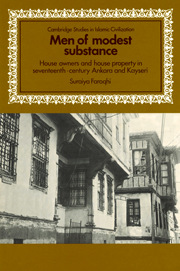Book contents
- Frontmatter
- Contents
- Tables
- Graphs
- Illustrations
- Figures
- Abbreviations
- Preface
- Introduction
- 1 Setting the scene: two cities of central Anatolia
- 2 The physical shape of urban houses
- 3 The cost of buying a house
- 4 Urban property-owners
- 5 The difficulties of an urban property-owner
- Conclusion
- Glossary
- Notes
- Bibliography
- Index
3 - The cost of buying a house
Published online by Cambridge University Press: 18 November 2009
- Frontmatter
- Contents
- Tables
- Graphs
- Illustrations
- Figures
- Abbreviations
- Preface
- Introduction
- 1 Setting the scene: two cities of central Anatolia
- 2 The physical shape of urban houses
- 3 The cost of buying a house
- 4 Urban property-owners
- 5 The difficulties of an urban property-owner
- Conclusion
- Glossary
- Notes
- Bibliography
- Index
Summary
In seventeenth-century Ankara and Kayseri, it was not totally unknown for people to live in rented houses. However, the case was exceptional, and the majority of people appear to have owned their dwellings. Yet that does not mean that every family purchased a house built by a professional craftsman. Evidence for the organization of the building crafts is not very plentiful in the kadıs' registers, and thus we know very little about how ordinary town dwellers built their houses. However, this very fact makes it appear probable that many people, particularly if they were poor, constructed their own houses, perhaps with the help of a few neighbours or relatives. If these assumptions are at all realistic, houses of the period with which we are dealing should be considered a ‘marketable commodity’ only in a limited sense.
Monetary units
On the other hand, the buying and selling of houses occurred frequently enough that we can make more or less coherent statements about the price of urban dwellings. However, as a preliminary, a few remarks about the monetary units used in seventeenth-century Anatolia are indispensable. Least complicated, at least at first glance, is the case of late-sixteenth- and early-seventeenth-century Ankara. For in this town the standard Ottoman monetary unit of the times, the akçe, was employed in almost all cases in which the relevant monetary unit has been clearly stated by the kadıs' scribes. There were a few rare instances in which house prices were expressed in gold coins (altin), by which term the scribes probably designated the standard Ottoman gold coin of the times, the sikke-i hasene (cf. Table 1).
- Type
- Chapter
- Information
- Men of Modest SubstanceHouse Owners and House Property in Seventeenth-Century Ankara and Kayseri, pp. 116 - 149Publisher: Cambridge University PressPrint publication year: 1987



